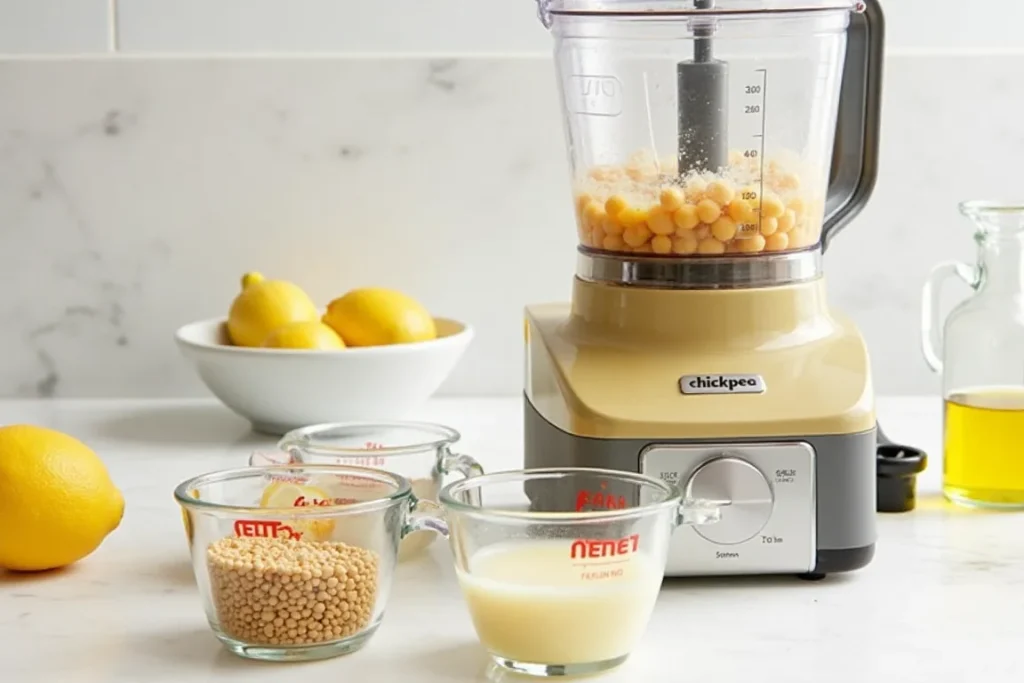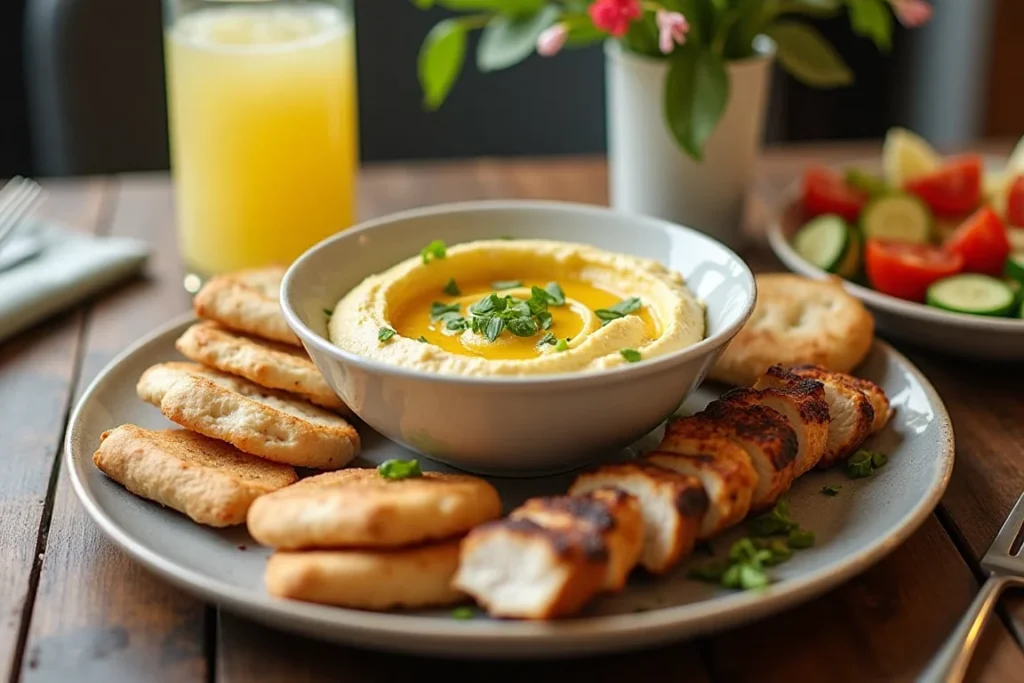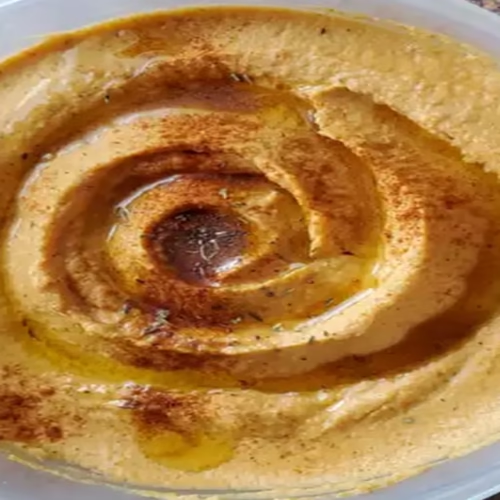Authentic traditional hummus is not just a dish; it is also a cultural treasure that has been loved in Middle Eastern cuisine for hundreds of years. This beloved Middle Eastern dip offers a connection to the rich history and vibrant traditions of the region. Learn more about its cultural significance and preparation on its dedicated Wikipedia page. In fact, this creamy and healthy spread, made from chickpeas, tahini, lemon, and garlic, shows how simple ingredients can create rich and satisfying flavors.
Moreover, hummus is celebrated for its versatility, as it works well as a dip, a spread, or even as the base for other creative dishes. For example, its earthy flavor pairs wonderfully with fresh vegetables, warm pita bread, or grilled meats. Because of this, it has become a favorite choice for both family meals and gatherings with friends.
In addition to its taste, hummus is packed with plant-based protein, fiber, and healthy fats, which help support a balanced diet. This means it is not only delicious but also good for your health.
Whether you make it at home or enjoy it at a restaurant, hummus offers a connection to the rich history and vibrant traditions of the Middle East. All in all, it is a simple yet delicious way to bring people together while celebrating its cultural roots.
Benefits of Authentic Traditional Hummus
Authentic traditional hummus offers more than just a delicious taste; it provides a wide array of health and practical benefits, making it a staple in many households. Here’s why this Middle Eastern delight deserves a place on your plate:
1. Nutrient-Rich and Healthy
- High in Plant-Based Protein: Chickpeas, the primary ingredient in hummus, are an excellent source of plant-based protein, making it ideal for vegetarians and vegans.
- Rich in Fiber: Promotes digestion, keeps you feeling full, and supports gut health.
- Loaded with Healthy Fats: Tahini and olive oil provide heart-healthy fats that support cardiovascular health.
- Packed with Vitamins and Minerals: Contains iron, magnesium, potassium, and vitamin B6 for overall wellness.
2. Weight Management
- Low in Calories: Hummus is naturally low in calories, making it a guilt-free snack.
- Satisfying and Filling: Its high protein and fiber content keep hunger at bay and prevent overeating.
3. Versatility
- Diverse Uses: Enjoy it as a dip for vegetables, a spread for sandwiches, a topping for salads, or a side dish for grilled meats and falafel.
- Customizable: Add spices, roasted vegetables, or herbs to create unique flavor variations.
4. Dietary-Friendly
- Gluten-Free: Perfect for those with gluten sensitivities or celiac disease.
- Vegan and Dairy-Free: Suitable for plant-based diets without any need for modifications.
- Low Glycemic Index: Ideal for individuals with diabetes as it helps regulate blood sugar levels.
5. Boosts Energy
- Complex Carbohydrates: Chickpeas provide sustained energy, making hummus an excellent pre- or post-workout snack.
- Essential Nutrients: The balance of protein, healthy fats, and carbs fuels your body effectively.
6. Supports Heart Health
- Heart-Healthy Fats: Olive oil and tahini reduce bad cholesterol and improve good cholesterol levels.
- Rich in Antioxidants: Ingredients like garlic and olive oil help combat inflammation and oxidative stress.
7. Cultural and Culinary Experience
- Rich in Tradition: Connects you to centuries of Middle Eastern culinary history.
- Easy to Make: Requires only a few simple ingredients and can be prepared quickly at home.
Hummus pairs well with various foods, including fresh vegetables, pita bread, or crackers. It’s also ideal as a sandwich spread, salad topping, or a side for dishes like Authentic Crown Fried Chicken or Olive Garden Zuppa Toscana Soup.
Ingredients for Authentic Traditional Hummus
- Chickpeas (1 ½ cups or 1 can, drained and rinsed): Provides a creamy base and earthy flavor.
- Tahini (¼ cup): Adds richness and a nutty taste essential for authenticity.
- Garlic (2 cloves): Enhances the flavor with a subtle pungency.
- Lemon Juice (2 tablespoons): Brightens the dish with a tangy zest.
- Olive Oil (2 tablespoons): Adds smoothness and depth of flavor.
- Salt (to taste): Balances and elevates the taste.
- Cold Water (2–4 tablespoons): Achieves the perfect creamy consistency.
Step-by-Step Preparation

Follow these simple steps to create a creamy, flavorful, and authentic Middle Eastern hummus. By carefully preparing each component, you’ll achieve the perfect texture and taste.
Prepare Chickpeas
- If using dried chickpeas, soak them overnight and cook them until soft. Alternatively, use canned chickpeas for convenience, rinsing and draining them thoroughly.
- For extra creaminess, remove the skins from the chickpeas. While optional, this step enhances the smoothness of the final hummus.
Blend the Base
- Add the cooked or canned chickpeas to a food processor. Next, add tahini, minced garlic, and fresh lemon juice. Blend until the mixture begins to combine into a thick paste.
Add Olive Oil and Seasoning
- Drizzle in olive oil and add salt to taste. At this stage, you can also incorporate optional seasonings like cumin or paprika for additional flavor. Continue blending to incorporate.
Incorporate Water
- Gradually add cold water, one tablespoon at a time, while blending. This step is crucial for achieving a silky, smooth texture. Adjust the water quantity based on your preferred consistency.
Taste and Adjust
- Taste the hummus and adjust the seasoning as needed. If it’s too tangy, add a bit more tahini. If it needs brightness, add an extra squeeze of lemon juice.
Transfer the hummus to a serving bowl and use the back of a spoon to create a swirl on the surface for a nice presentation. Next, drizzle olive oil generously over the top to enhance the flavor. Then, garnish with paprika, cumin, or chopped parsley for a burst of color. For extra texture, you can add toppings like whole chickpeas, toasted pine nuts, or sesame seeds. With these finishing touches, your hummus will look as good as it tastes!
Advanced Tips and Variations
Take your hummus to the next level with these expert tips and creative variations. By incorporating these ideas, you can elevate both the flavor and texture of this beloved dish.
- Add a teaspoon of baking soda to the water when cooking dried chickpeas. This helps soften the chickpeas faster, making them easier to blend and resulting in an ultra-creamy texture.
- For the creamiest hummus, remove the skins from the chickpeas. Although time-consuming, this step significantly enhances the smoothness.
- Add ice-cold water while blending to emulsify the tahini and create a fluffier, lighter texture. This small trick makes a big difference in the final result.
- Replace raw garlic with roasted garlic for a sweeter, more mellow flavor. This adds depth without overpowering the hummus.
- Use a combination of lemon juice and white vinegar to balance acidity. This creates a tangy, well-rounded flavor.
- Allow the food processor to run for a few extra minutes. The extended blending time ensures a smoother, creamier consistency.
Creative Variations for Unique Hummus Flavors

Hummus is a versatile dish, and there are so many creative ways to make it even more exciting. For instance, if you enjoy spicy flavors, you can add harissa paste or chili oil to create a bold and fiery hummus. On the other hand, blending fresh herbs like parsley or cilantro will give you a refreshing, green version perfect for summer snacks. Moreover, roasted red peppers and smoked paprika can add a smoky and slightly sweet flavor, which pairs wonderfully with grilled vegetables. If you’re looking for something colorful, blending roasted beets creates a vibrant pink hummus with an earthy taste. Additionally, sun-dried tomatoes and basil can bring a Mediterranean twist, while avocado adds a creamy texture and a guacamole-like flavor. Finally, for a sweet and savory mix, try adding roasted sweet potatoes and cinnamon for a fall-inspired treat. With these ideas, hummus never gets boring!
1.
Discover how to transform traditional hummus into exciting variations! Each recipe offers a unique twist, perfect for snacks, appetizers, or meals. Moreover, these ideas are simple, flavorful, and sure to impress.
1. Spicy Harissa Hummus
How to Make: To begin with, blend a tablespoon of harissa paste or chili oil into your hummus. Additionally, you can adjust the spice level to suit your taste.
Top With: For an extra kick, sprinkle crushed red pepper flakes on top.
2. Herbed Hummus
How to Make: First, blend fresh herbs such as parsley, cilantro, or dill into your hummus. Consequently, this creates a vibrant green color and a refreshing, earthy flavor.
Result: As a result, you get a deliciously herbaceous dip that pairs well with fresh vegetables or crackers.
3. Roasted Red Pepper Hummus
How to Make: Start by adding roasted red peppers and a pinch of smoked paprika to your hummus. Then, blend until smooth.
Pair With: Furthermore, serve it with grilled vegetables to enjoy a smoky and sweet combination.
4. Beetroot Hummus
How to Make: Initially, blend roasted or boiled beets into your hummus. In addition, you can adjust the amount of beet to customize the intensity of the color and flavor.
Garnish With: To finish, crumble feta cheese on top, offering a beautiful contrast in both taste and appearance.
5. Sun-Dried Tomato Hummus
How to Make: Begin by mixing in sun-dried tomatoes and a touch of basil into your hummus. Afterward, blend until fully combined.
Enhance With: Not only can you drizzle garlic-infused olive oil over the top, but you can also sprinkle some chopped basil for extra flavor.
Storing Hummus

Proper storage is key to maintaining the flavor, freshness, and texture of your homemade or store-bought hummus. To begin with, always store hummus in an airtight container to prevent it from drying out or absorbing other odors. If it’s homemade, refrigerate it immediately after preparation to keep it fresh. In addition, avoid leaving hummus at room temperature for extended periods, as this can lead to spoilage. For store-bought hummus, check the expiration date and keep it tightly sealed after each use. Moreover, freezing is an option for longer storage; just be sure to thaw it in the refrigerator and stir well before serving. By following these guidelines, you can ensure your hummus stays delicious and safe to eat for as long as possible.
Use an Airtight Container:
- Always transfer hummus to a clean, airtight container to prevent air exposure, which can dry it out and reduce its flavor.
Seal with Olive Oil:
- Add a thin layer of olive oil on top before sealing the container. This acts as a protective barrier, keeping the hummus moist and fresh.
Refrigeration Duration:
- Store hummus in the refrigerator at or below 4°C (39°F).
- Homemade Hummus: Typically lasts 4–7 days.
- Store-Bought Hummus: Lasts up to the expiration date when unopened and about 5 days after opening.
Label with Date:
- For homemade hummus, label the container with the preparation date to easily track freshness.
Freezing Hummus (Optional)
Is Hummus Freezable?
- Yes, hummus freezes well! While its texture may slightly change after thawing, freezing is an excellent method to extend its shelf life.
How to Freeze:
- Portion the hummus into freezer-safe containers or resealable bags.
- Leave some space at the top, as hummus expands slightly when frozen.
Thawing Instructions:
- Transfer the frozen hummus to the refrigerator and allow it to thaw overnight.
- Once thawed, stir well and add a splash of olive oil or water to restore its creamy texture.
Freezer Shelf Life:
- Hummus can be stored in the freezer for up to 3 months without losing its quality significantly.
Avoid Contamination
Use Clean Utensils:
- Always use a clean spoon or knife to scoop out hummus. Avoid double-dipping, as it can introduce bacteria and shorten its shelf life.
Avoid Leaving at Room Temperature:
- Do not leave hummus out for longer than 2 hours, as this creates an environment for bacterial growth.
4. Restoring Freshness
Revive Dry Hummus:
- If your hummus begins to dry out, don’t worry! Simply mix in a splash of water, olive oil, or lemon juice. This will instantly restore its creamy texture and make it as good as new.
Enhance Flavor:
- Add a pinch of salt, garlic, or extra lemon juice to restore and brighten the flavor.
Authentic Traditional Hummus Nutritional Value (per 2 tablespoons)

Authentic Traditional Hummus is not only delicious but also a nutritious addition to your diet. For instance, here’s the approximate nutritional breakdown for 2 tablespoons (about 30g) of traditional hummus:
- Calories: 70
- Protein: 2 grams
- Fat: 5 grams (mostly healthy unsaturated fats)
- Carbohydrates: 4 grams
- Fiber: 1 gram
- Sugar: Less than 1 gram
- Sodium: Around 80 milligrams
Additionally, Authentic Traditional Hummus is a good source of plant-based protein and healthy fats, making it a satisfying and energy-boosting choice. Because it’s made with wholesome ingredients like chickpeas, tahini, and olive oil, it also contains essential nutrients such as iron, magnesium, and B vitamins. Therefore, incorporating hummus into your meals can contribute to a balanced and nutrient-rich diet.
Micronutrients
- Calcium: 15–20 mg (1–2% of daily value).
- Iron: 0.5 mg (3% of daily value).
- Potassium: 50–60 mg.
- Magnesium: 10–15 mg.
- Vitamin B6: 0.1 mg (5% of daily value).
Key Ingredients and Their Contributions
- Chickpeas: Rich in protein, fiber, and healthy carbs, they keep you feeling full and aid in digestion.
- Tahini (Sesame Paste): Packed with healthy fats, it also provides essential nutrients like calcium, iron, and magnesium.
- Olive Oil: A great source of heart-healthy monounsaturated fats that boost overall well-being.
- Garlic: Loaded with antioxidants and immune-boosting compounds that promote good health.
- Lemon Juice: High in vitamin C, it enhances flavor while supporting digestion.
Health Benefits
- Low in Calories: Helps with weight management since it’s filling and packed with nutrients.
- Rich in Plant-Based Protein: A great option for vegetarians and vegans.
- Healthy Fats: Boosts heart health and provides energy.
- High in Fiber: Supports digestion and helps control blood sugar levels.
Perfect Pairings for Hummus

Authentic Traditional Hummus is a versatile dish that goes perfectly with fresh veggies, crispy pita bread, or crunchy biscuits. It’s also a fantastic addition as a sandwich spread, a salad topping, or a flavorful side dish to go with meals such as Authentic Crown Fried Chicken or the savory Olive Garden Zuppa Toscana Soup. These combinations change everyday meals into vibrant, healthy experiences.

Authentic Traditional Hummus
Ingredients
- 2 cups cooked chickpeas
- 1/4 cup tahini
- 3 tablespoons lemon juice freshly squeezed
- 2 cloves garlic
- 2 tablespoons olive oil plus extra for serving
- Salt to taste
- 1/2 teaspoon ground cumin
- Paprika for garnish optional
Instructions
Blend the Ingredients:
- In a food processor, combine chickpeas, tahini, lemon juice, garlic, olive oil, ground cumin, and salt. Blend until smooth and creamy.
Adjust and Serve:
- If the hummus is too thick, add water one tablespoon at a time to reach your desired consistency. Taste and adjust seasoning if needed.
- Transfer the hummus to a serving bowl. Drizzle with olive oil and sprinkle with paprika if desired. Serve with pita bread, fresh vegetables, or as a spread.
Notes
FAQs
1. Can I use dried chickpeas?
Yes! First, soak them overnight, then cook until tender, and finally, proceed with the recipe.
2. What can I use instead of tahini?
Substitute with almond or sunflower seed butter for a similar texture.
3. Is hummus low-carb?
Not entirely. However, you can replace chickpeas with cauliflower to create a low-carb option.
4. What pairs well with hummus?
it’s pairs beautifully with fresh veggies, works great with pita bread, and also serves as a tasty spread for wraps and sandwiches.
Hummus is more than just a tasty dish. Hummus is healthy, versatile, and deeply connected to a rich tradition. Its creamy texture and balanced nutrients make it a perfect option for both snacks and meals.
Furthermore, its lasting fame shows how well it combines flavor with health.
For instance, you can enjoy hummus as a dip for fresh veggies, a spread for bread, or a base for creative recipes. In addition, its adaptability allows it to fit into many diets. It also brings both great taste and nutrition to your table, making it a essential in any kitchen.
By learning to make hummus and trying different recipes, you can add both flavor and health to your meals. Also, this simple yet versatile dish works well with many cooking styles. So, give this lasting classic a try and enjoy its delicious mix of flavor and health.

